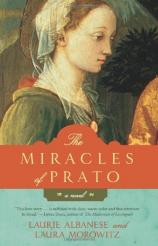Reading Group Guide
Discussion Questions
The Miracles of Prato

1. What are the many "miracles of Prato" and why do you think the authors chose this title?
2. How is your experience of the novel enhanced (or diminished) by looking at the website documenting the restoration of Fra Lippi's Prato frescoes?
3. A woman's life in medieval and Renaissance Italy was largely limited to one of three roles: wife, nun, or prostitute. How is this reflected in the novel's female characters? Do you think Lucrezia successfully transcends these social limitations? Why or why not?
4. Why do you think Lucrezia ultimately decides to go with Fra Filippo and to allow their relationship to become sexual? Do you think the decision was wise? Moral? Inevitable?
5. The church was arguably the most powerful institution in Renaissance Italy. Discuss the importance of the church, both positive and negative, in relation to Fra Filippo's life and development as a man and as an artist.
6. Fra Filippo tells Lucrezia, "to paint is to pray." How do Fra Filippo, Lucrezia and Sister Pureza perceive and understand God differently? How does each express their faith?
7. Many important scenes unfold in the herb garden in the Convent Margherita. Discuss the meaning and symbolism of this setting. Consider Sister Pureza's wisdom in relation to her role as midwife and herb garden caretaker.
8. Is the convent a sanctuary, or a prison? For whom? Why?
9. What were the most vivid and convincing aspects of Fifteenth Century Italian life in the novel? What details in particular made this world come alive for you?
10. The novel may be seen as a meditation on beauty. What is the relationship in the book between external beauty and spiritual beauty? Between physical beauty and the creation of art? Between beauty, purity, and godliness? Do you agree with these associations as they are made in the novel? Can you explain how this relationship between beauty and faith might be appropriate to social and cultural realities in 15th Century Italy, and yet inappropriate by 21st Century cultural standards?
11. What did you learn about the daily life of an artist that surprised you? How might your approach to the study and appreciation of Renaissance art be changed after reading The Miracles of Prato?
12. The Holy Belt of the Virgin Mary is an important symbol in the novel, both as one of faith, and one of female power. What role does the belt play in the successful return of Lucrezia's baby? Do you believe this is a miracle, a human manipulation, or both?
13. The color red appears in many guises and in relation to many objects in the novel. Which objects can you think of and what is the symbolism behind them?
14. The Miracles of Prato is a collaboration between a novelist and an art historian. Can you see how this partnership benefited the story?
15. The novel is based on true events, but the authors take many liberties with the fragmented facts that history passed on to us. This is often an area of contention between historians and novelists. Do you have a bias toward or against fiction that liberally imagines the internal thoughts and private motives of public figures?
The Miracles of Prato
- Publication Date: February 2, 2010
- Paperback: 400 pages
- Publisher: William Morrow Paperbacks
- ISBN-10: 0061558354
- ISBN-13: 9780061558351








